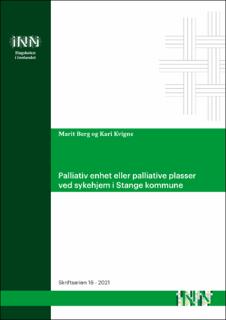| dc.contributor.author | Berg, Marit | |
| dc.contributor.author | Kvigne, Kari | |
| dc.date.accessioned | 2021-11-03T11:31:01Z | |
| dc.date.available | 2021-11-03T11:31:01Z | |
| dc.date.issued | 2021 | |
| dc.identifier.isbn | 978-82-8380-293-1 | |
| dc.identifier.issn | 2535-5678 | |
| dc.identifier.uri | https://hdl.handle.net/11250/2827561 | |
| dc.description | Oppdragsgiver: Stange kommune | en_US |
| dc.description.abstract | Høgskolen i Hedmark, avdeling for helse‐ og idrettsfag, institutt for sykepleiefag har på oppdrag fra Stange kommune utarbeidet foreliggende utredning om organisering av palliasjon i kommunen.
Utredningen tar for seg hva palliasjon er, fordeler og ulemper ved henholdsvis palliative senger i ordinær sykehjemsavdeling og egen palliativ enhet og økonomi knyttet til de ulike alternativene.
Palliasjon er aktiv behandling, pleie og omsorg for pasienter med uhelbredelig sykdom. Lindring av pasientens fysiske smerte og andre plagsomme symptomer, uavhengig av diagnose/sykdom, står sentralt. Målet er best mulig livskvalitet for pasienten og de pårørende. Dette innebærer at pasient og pårørende blir møtt og forstått i forhold til sin situasjon med uhelbredelig sykdom i familien. For å lykkes med palliasjon i kommunen kreves kompetanse hos personalet og tverrfaglig samarbeid – og samarbeid med spesialisthelsetjenesten i Sykehuset Innlandet HF.
Det foreligger erfaring fra andre kommuner i Norge med både palliative enheter i sykehjem og palliative senger i eksisterende sykehjemsavdelinger. Noen har gått enda ”lenger” og etablert intermediær (1 ½‐linje) avdeling i sykehjem, og noen har etablert hospice‐enhet. Disse erfaringene, forutsatt at folketallet i kommunen er større enn 10 – 15 000 innbyggere, tilsier at palliativ enhet har flere fordeler enn palliative senger i eksisterende sykehjemsavdeling.
Behandlingstilbudet i palliative enheter er kostbart i forhold til driften ved ordinære sykehjemsavdelinger, men billig i forhold til behandling i sykehus (Garåsen m.fl., 2003). I tråd med utspillene fra nåværende helseminister Bjarne Håkon Hansen den siste tiden, er det rimelig å anta at kommunen dermed vil få et utvidet ansvar i forhold til pasientgruppene med behov for palliasjon framover.
Utfordringen er å ta stilling til på hvilken måte Stange kommune skal løse dette: Palliaitv enhet eller palliative senger i sykehjem? Hvilken kompetanse er nødvendig for å håndtere utfordringene? Hvilke økonomiske konsekvenser gir realisering og drifting av tiltaket som velges? | en_US |
| dc.description.abstract | Abstract: Hedmark University, Department of Health and Sports Sciences, Department of Nursing, has, on behalf of Stange Municipality, prepared the present report on the organization of palliative care in the municipality.
The report addresses what palliative care is, the advantages and disadvantages of palliative beds in the ordinary nursing home ward and its own palliative care unit and finances related to the various alternatives.
Palliative care is active treatment, nursing and care for patients with incurable disease. Relief of the patient's physical pain and other troublesome symptoms, regardless of diagnosis / illness, is the key. The goal isthe best possible quality of life forthe patient and the relatives. This meansthat the patient and relatives are met and understood in relation to theirsituation with incurable disease in the family. In order to succeed with palliative care in the municipality, the competence of the staff and interdisciplinary collaboration is required ‐ and collaboration with the specialist health service at Sykehuset Innlandet HF.
There is experience from other municipalities in Norway with both palliative units in nursing homes and palliative beds in existing nursing home wards. Some have gone even “further” and established an intermediate (1 ½‐line) ward in a nursing home, and some have established a hospice unit. These experiences, provided that the population in the municipality is greater than 10 ‐ 15 000 inhabitants, indicate that the palliative care unit has more advantages than palliative care beds in the existing nursing home ward.
The treatment offered in palliative care units is expensive in relation to the operation of ordinary nursing home wards, but cheap in relation to treatment in hospitals (Garåsen et al., 2003). In line with the proposalsfrom the reasent Minister of Health Bjarne Håkon Hansen recently, it isreasonable to assume that the municipality will thus have an expanded responsibility in relation to the patient groups with a need for palliation in the future.
The challenge is to decide in which way Stange municipality will solve this: Palliaitv unit or palliative beds in nursing homes? What skills are needed to handle the challenges? What financial consequences does the realization and operation of the measure chosen have? | en_US |
| dc.language.iso | nob | en_US |
| dc.publisher | Høgskolen i Innlandet | en_US |
| dc.relation.ispartofseries | Skriftserien;16/2021 | |
| dc.subject | utredning | en_US |
| dc.subject | palliativ | en_US |
| dc.subject | palliative plasser | en_US |
| dc.subject | palliativ enhet | en_US |
| dc.subject | sykehjem | en_US |
| dc.subject | examination | en_US |
| dc.subject | palliative care | en_US |
| dc.subject | palliative care places | en_US |
| dc.subject | palliative care unit | en_US |
| dc.subject | nursing home | en_US |
| dc.title | Palliativ enhet eller palliative plasser ved sykehjem i Stange kommune | en_US |
| dc.type | Research report | en_US |
| dc.description.version | publishedVersion | en_US |
| dc.rights.holder | © Forfatteren/Høgskolen i Innlandet, 2021 | en_US |
| dc.subject.nsi | VDP::Medisinske Fag: 700::Helsefag: 800::Sykepleievitenskap: 808 | en_US |
| dc.source.pagenumber | 47 | en_US |
